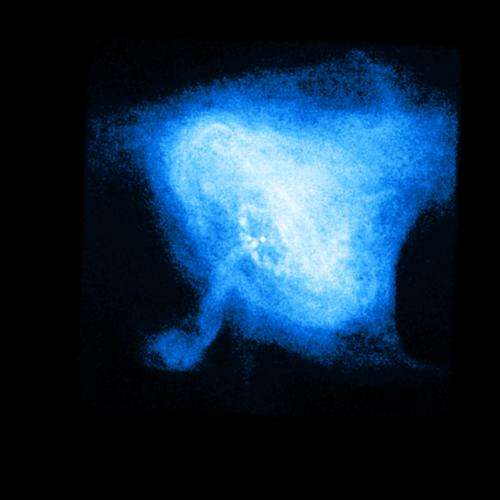Crab nebula: The crab in action & the case of the dog that did not bark

A new movie from NASA's Chandra X-ray Observatory shows a sequence of Chandra images of the Crab Nebula, taken over an interval of seven months. Dramatic variations are seen, including the expansion of a ring of X-ray emission around the pulsar (white dot near center) and changes in the knots within this ring.
However, arguably the most striking result of these observations is the variations that were not observed, or in analogy with a famous Sherlock Holmes story1, this could be a case where the fact that the dog that did not bark helps to solve a mystery.
The pulsar at the center of the Crab Nebula is a neutron star that spins around about 30 times a second. It was created from a supernova explosion in our galaxy that was observed by astronomers in China and other countries in the year 1054.
As the young pulsar slows down, large amounts of energy are injected into its surroundings. In particular, a high-speed wind of matter and anti-matter particles plows into the surrounding nebula, creating a shock wave that forms the expanding ring seen in the movie. Jets from the poles of the pulsar spew X-ray emitting matter and antimatter particles in a direction perpendicular to the ring.
The goal of these latest Chandra observations was to pinpoint the location of remarkable gamma-ray flares observed by NASA's Fermi Gamma Ray Observatory and Italy's AGILE Satellite. A strong gamma-ray flare was observed from the Crab in September 2010, followed by an even stronger series of "superflares" in April 2011. The gamma-ray observatories were not able to locate the source of the flares within the nebula, but it was hoped that Chandra, with its high-resolution images, would.
Chandra began observing the Crab on monthly intervals beginning six days after the discovery of the gamma-ray flare in September 2010. This established a baseline of seven images of the nebula before the superflare was seen just last month.
When Fermi scientists saw that more flaring activity was beginning in April 2011, a pre-planned set of five Chandra observations was initiated. Two of these observations were made when strong gamma-ray flares occurred, but no clear evidence was seen for correlated flares in the Chandra images. The movie shows the April observations in "slow motion" to focus on the time when the gamma-ray superflares occurred. The movie shows three loops through the sequence of images, along with a timeline near the bottom.
Despite the lack of a "barking dog" in the X-ray data, these observations, as in the Sherlock Holmes story 1, will help scientists to home in on an explanation of the gamma-ray flares. The Chandra data provide strong constraints on the behavior, at relatively low energies, of the particles that have been accelerated to produce the gamma-ray flares. Another possible explanation follows if the gamma-ray flaring occurred in regions very close to the pulsar. Then they would have been missed by Chandra, because the Crab pulsar is so bright that the detectors are in essence "overexposed" so variations from that region cannot be observed. Note that in the movie an artificial source of constant brightness is included to show the position of the pulsar.
Provided by Chandra X-ray Center




















